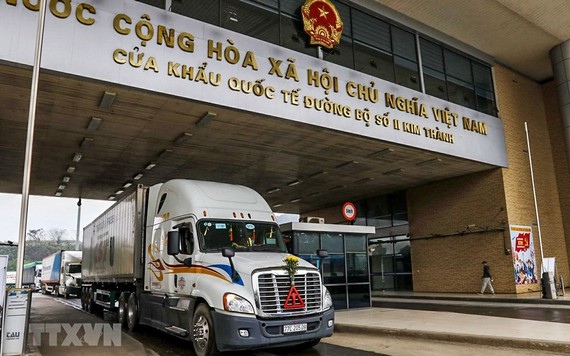China tightens conditions for import of Vietnamese goods
China tightens conditions for import of Vietnamese goods
China has recently introduced extremely strict measures to control the coronavirus by tightening conditions for import of all goods, packaging methods, as well as means of transportation of agricultural produce from Vietnam.
Ilustrative photo. |
These measures have made it much more difficult for Vietnamese fresh agricultural produce to enter the Chinese market within an allotted time frame.
Increase in costs
On 19 August, the Import-Export Department of the Ministry of Industry and Trade, stated that China had asked that pandemic prevention and control measures be upgraded in the process of Vietnamese goods entering China through the Tan Thanh border gate in Lang Son Province. From 18 August, drivers transporting Vietnamese goods have not been allowed to enter China, but instead have had to hand over the goods to Chinese drivers across the border for delivery to customers. The Ministry of Industry and Trade has assessed that this form of transhipment of goods at the border would increase both costs and risks for exporters, especially for fresh agricultural produce that needs immediate delivery.
In September, authorities in Dong Hung in Guangxi Region of China, announced suspension of import clearance for dragon fruit from Vietnam through the Dong Hung temporary pontoon bridge for seven days, from 15 September to 21 September. This was due to detection of the SARS-CoV-2 virus on the packaging of dragon fruit and the carton boxes containing dragon fruit packed from Vietnam.
Mr. Dang Phuc Nguyen, General Secretary of the Vietnam Fruit and Vegetable Association, spoke with Saigon Investment, saying that due to China’s aim for zero Covid within its country, there are now severe and extreme tightened measures in place to receive goods across the border since the end of May and beginning of June. Previously, authorities checked and disinfected each batch as it came in.
However, when the pandemic broke out in the Southern provinces yet again, authorities began to check and disinfect each single box. In addition, of the nine types of fruits exported to China, there are eight types that have not yet signed an agreement on phytosanitary, so the inspection of goods is also more stringent. This will cause agricultural businesses to bear additional costs and risks when exporting fruits to China.
According to Mr. Dang Phuc Nguyen, when the time for inspection and disinfection is extended, the cost of running a generator to keep containers in cold storage increases substantially, and if delayed for too long, the quality of the fruit is affected. He believes that if fruit such as dragon fruit is held under such conditions for ten days at a stretch then the quality and taste of the fruit is certainly affected. Mr. Nguyen said that this is also one of the reasons why this year export of vegetables and fruits had difficulty in reaching the assigned destination, and despite expectation of recovery of USD 4 bn, the target fell short at USD 3.5 bn.
Actually, China is not only strict in the quarantine process of goods, but has also issued new regulations since the beginning of the year in its attempt to contain and control the pandemic. From January until October, China issued 42 notices related to food safety and animal and plant quarantine. More recently, China introduced a new standard, stipulating more than 10,000 maximum residue limits, compared to the document issued in 2019. This new standard covers 81 types of pesticides, and the number of types with limited pesticide residues adds to nearly 3,000 different types.
In addition, China published a list of phytosanitary measures for 500 different species of micro-organisms. In these, there are many common harmful organisms such as aphids, stem borers, and fruit borers, which often exist in fresh fruits from Vietnam. Now, as China continues to tighten on standards for importing agricultural produce from Vietnam, it will be increasingly difficult for Vietnamese agricultural produce to enter the Chinese market.
Vietnam must adapt
For a long time, China was considered an easy market and a major export market for Vietnamese agricultural produce. With the implementation of strict regulations and multiple changes, Vietnam will find it difficult to adapt and change accordingly.
Speaking with Saigon Investment, Mr. Dang Phuc Nguyen said that although China is increasing its demands, the standards of this market are still lower than other difficult markets such as the US, Europe, or Japan. Therefore, with more and more difficult markets cropping up for Vietnamese agricultural products, there is no reason why Vietnam cannot enter the Chinese market easily. The important thing is to work towards delivering the goods. Accordingly, export businesses will urge cultivating areas and ask each farmer to do the right thing. For a long time, farmers still have the age old habit of doing things the easy way, which all needs to change gradually.
Ms. Ngo Tuong Vy, Deputy General Director of the Chanh Thu Company, agreed with Mr. Nguyen, in that the new regulations of the Chinese market are a signal for Vietnam's agricultural production units to change their mindset. In order to export, both enterprises and production facilities must ensure that higher standards are set forth in future. In recent years, the export of vegetables and fruits to the Chinese market has been decreasing and shifting to more fastidious markets. Specifically, in 2020, China accounted for 57% of the market share, while in 2021 it is estimated to decrease to 55%. On the other hand, the European and American markets saw strong growth, but exporting to these markets is also full of difficulties.
Firstly, goods must meet the high standards required, and also simultaneously offer long-term stability. Secondly, high transportation costs and lack of empty containers makes transport time longer, which also significantly affects the quality of fruits and vegetables when exporting by sea to EU and US markets.




















